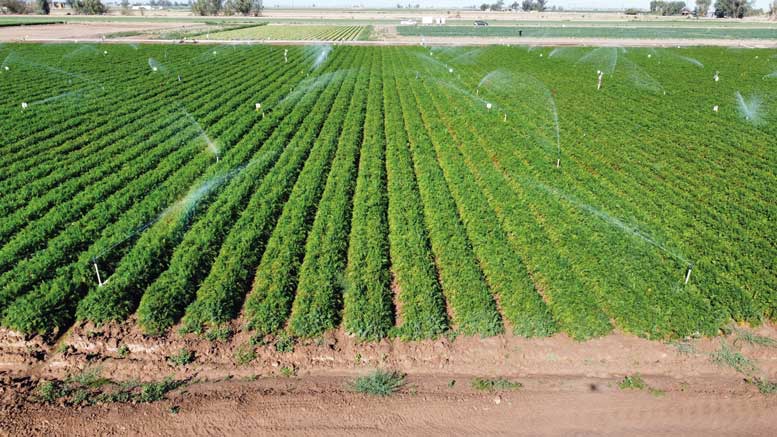|
Click to listen to this article
|
By Ali Montazar, Michael Cahn and Jaspreet Sidhu, University of California Cooperative Extension; and Daniel Geisseler, University of California – Davis
Water and nitrogen (N) management in carrots is critical for increasing efficiency of crop production by decreasing costs and nitrate leaching losses. This will become increasingly important with high fertilizer prices, and as water quality and quantity concerns continue to increase. To maximize yield and quality, carrots need a sufficient level of N in the soil. Matching N fertilizer applications with carrot N uptake, and water applied with crop water requirements can optimize N and water use efficiency, as well as crop yield and quality.
A study was conducted to gain information on improving and promoting adoption of management practices that optimize N and irrigation water use efficiency in California carrot production systems.
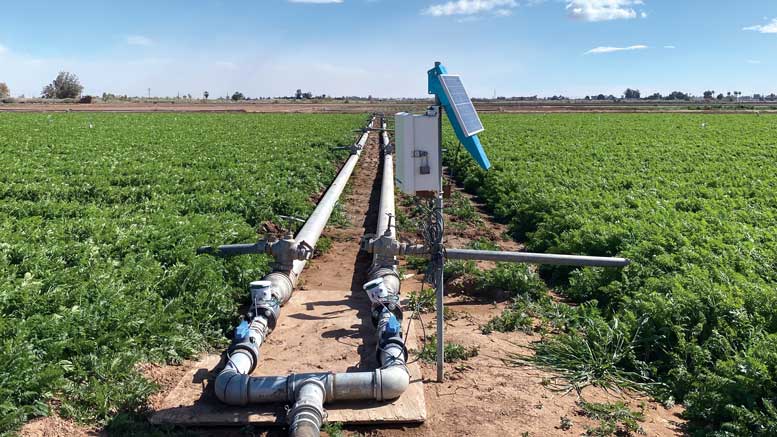
Field Experiment
A two-year study (October 2021 through March 2023) was conducted at the University of California Desert Research and Extension Center in Holtville, California (Fig. 1). The experiment consisted of three N fertilizer strategies (N1, N2, N3) under two irrigation regimes (I1, I2). The trials were arranged in a randomized complete block with split plot arrangement over four replications. Each sub-plot included 12 beds 40 inches wide and 60 feet long. Ten lines of Choctaw fresh market carrots were seeded in each bed.
The dates of first irrigation and harvest were Oct. 8, 2021, and March 17, 2022, for the 2021-22 trial, respectively. These dates were Oct. 4, 2022, and March 14, 2023, for the 2022-23 trial, respectively. Solid set sprinklers were used to irrigate the trials throughout both seasons. The study field of the 2021-22 season had a sandy clay loam (top 1 foot) to sandy loam (1-3 feet) soil texture. The soil texture of the field in the 2022-23 season was silty loam at the top 2 feet and sandy loam below 2-foot depth.
The water applied to the irrigation treatments was monitored using magnetic flowmeters on a 30-minute basis (Fig. 2). Actual soil nitrate content (NO3-N) and total N percentage in tops and roots were determined monthly through laboratory analysis. Preplant and post-harvest soil samples were taken from six depths (1-6 feet). At other sampling dates, soil was collected from the top three depths (1-3 feet). A composite soil sample was analyzed from each layer for NO3-N content.
Canopy images were taken on a weekly to a 15-day basis utilizing an infrared camera to quantify crop canopy coverage over the crop seasons.
Plant measurement was carried out on 40-plant samples collected randomly per plot, and determinations of fresh and dry weights of roots and foliage were made on a regular monthly basis during the seasons. The plant measurement was conducted on 100-plant samples per plot at harvest.
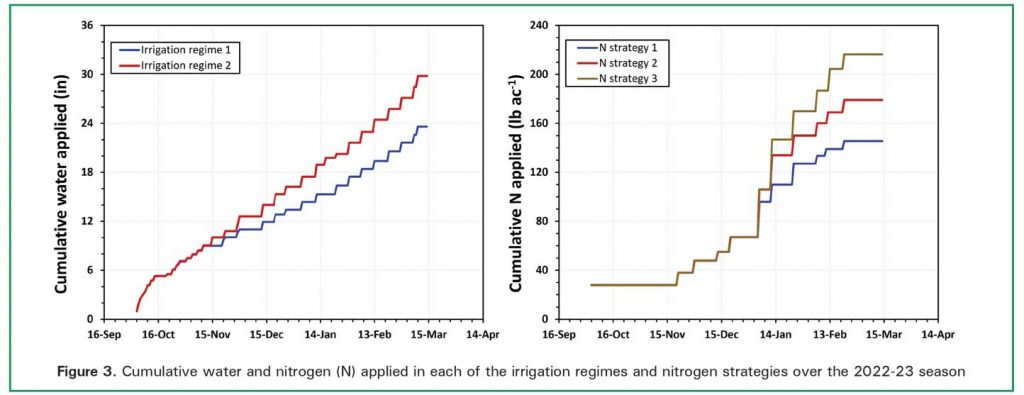
Water and Nitrogen Applied
The seasonal water and N applications in the different irrigation regimes and N strategies are listed in Table 1. A preplant N fertilizer with monoammonium phosphate was broadcast at a rate of 280 lbs./ac over the entire trial area in both seasons. Urea ammonium nitrate (UAN-32) was injected into the sprinkler system to supply the remaining amount of N for each nitrogen treatment. The application rates varied from 140 to 235 lbs. N/ac in the 2021-22 season and from 145 to 217 lbs. N/ac in the 2022-23 season.
The amount of irrigation water was determined using the CropManage irrigation and nitrogen decision management tool (www.cropmanage.ucanr.edu) to provide 100 percent of crop water needs (ET or irrigation regime 1) and 25 percent more than crop water needs (125 percent ET or irrigation regime 2). The amounts of irrigation varied from 24.5 to 30.8 in. and from 23.6 to 29.7 in. in the 2021-22 and 2022-23 seasons, respectively (Table 1). The trends of water and N applications per event for the 2022-23 season can be found in Fig. 3.
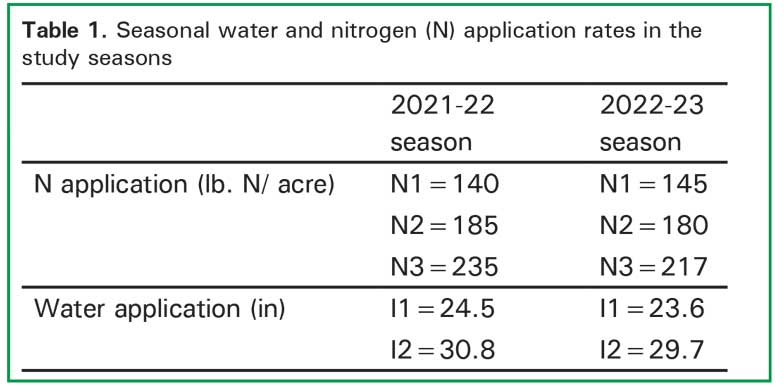
Impact on Nitrogen Uptake
Data of this study reported in an earlier article suggested that nearly 50 percent of the total N in carrots is taken up during a 50-day period, 80-130 days after seeding. This 50-day period appears to be the most critical period for N uptake, particularly in the storage roots, when carrots developed the large canopy and the extensive rooting system. The findings also demonstrated that for a 160-day crop season in the low desert of California, 22 percent of N uptake took place over the last 30 days before harvest.
The highest N accumulation rates at harvest were associated with the N2 treatment under the I2 irrigation regime (273 lbs. ac-1) and the N3 treatment under the I1 irrigation regime (281 lbs. ac-1) in the 2022-23 season (Fig. 4). However, nitrogen application rates had no statistically significant effect on total N uptake (roots and tops) and the N accumulated in roots. The N application rate had a clear and scientifically significant effect on increasing aboveground foliage (tops), which could be a reason for greater nitrogen uptake at the higher rate of N applied.
The results provide evidence for an overall effect of the interaction of irrigation regime and nitrogen management strategy on the total N accumulation in carrots (roots and tops) even though the irrigation regime as an individual driver had no significant effect on the N accumulation (neither the total nor tops or roots). It is likely relevant to the range of water application rates. The 25 percent over-irrigation couldn’t have a considerable impact on leaching nitrate within a silty loam soil type. A higher amount of excessive water through a more aggressive over-irrigation scenario (for instance, 150 percent ET) could influence the N uptake differently. The results of nitrogen accumulation were basically consistent within the two seasons.

Impact on Carrot Fresh Roots
Although no statistically significant impacts were found from both irrigation and N application rates on the fresh root yield in the 2022-23 season, N application statistically affected root yield in the 2021-22 season (Fig. 5). The lowest fresh root yield (40.8 t ac-1) was observed in the I2N1 treatment (irrigation regime 2 and an N application rate of 140 lbs. ac-1). A lower soil residual nitrate content could have contributed to a lower root yield in this specific treatment in the 2021-22 season. A greater mineral N content in the top 2 feet of soil was determined right before planting in the 2022-23 season (106 lbs. N/ac) than in the 2021-22 season (77 lbs. N/ac).
Since residual soil N can contribute considerably to the N requirement in carrots, preplant soil nitrate-N assessment down to 2-ft. depth is a tool that can enable growers to improve N management and maximize yield and quality while minimizing economic and environmental costs.
The findings suggested insignificant difference of fresh root yields impacted by the interaction of irrigation regime and N strategy within the range of application rates in both seasons. Different results could be obtained in a field that is irrigated more than the I2 treatment (> 125 percent of CropManage recommendation), has a low residual nitrate content or/and has a sandy textured soil.
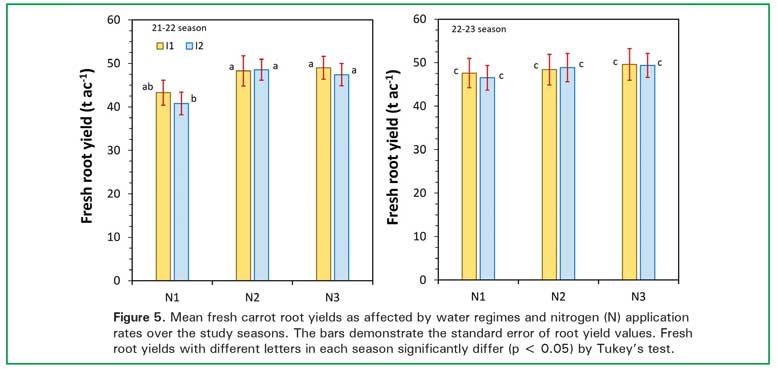
Conclusions
Nitrogen and irrigation water must be effectively used in mineral soils to produce carrots with high yield and with minimal environmental impact. In the low desert of California, the majority of N is taken up during the months of December to February, and hence, proper N fertility in the effective crop root zone is essential during this period. An integrated optimal N and water management plan needs to be followed to achieve high N and water efficiency, and consequently overall profitability.
Positive impact of N application rate on carrot root yield was observed, but statistically no significant relation was found. The findings of this study suggested that N application rates greater than 145 lbs. ac-1 do not have a significant impact on carrot root yield in a well-managed irrigated field with a silty loam soil texture (above 2 ft.) to sandy loam (below 2 ft.). However, the fact that more N was taken up in the crop than applied for the N1 and N2 treatments would suggest that the residual nitrate in the soil from the past season contributed to the N nutrition of the crop. Higher N rates are likely necessary in over-irrigated carrot fields (receiving more than 125 percent of crop ET), or fields with a low residual nitrate content. This is because improving N use efficiency is closely associated with water use efficiency. On sandy textured soils, water management can be especially important for achieving high N use efficiency in carrots. Carrots need variable seasonal water application that depends on planting time, length of season, variety, soil types and irrigation efficiency. In this study, we used CIMIS reference evapotranspiration data and a crop coefficient model applied through CropManage online software to estimate water requirements of carrot before each irrigation.
Growers are encouraged to try using a reduced N rate (10-20 percent lower than their current practice) on a small field to evaluate how it fits their specific farming practices before they adopt it on a widespread basis. Analyzing soil samples for residual soil nitrate early in the season (after the pre-irrigation) and in-season soil nitrate and leaf tissue analyses can provide confidence in the new practices and allow for corrective measures. Information on using the soil nitrate quick test can be found at www.cdfa.ca.gov/is/ffldrs/frep/pdfs/nitratequicktestweb.pdf. Sufficient N availability in the crop root zone over the growing season and the lack of significant yield response to N application within the range of N application rates in this study suggested that N optimal rates could be likely less than 180 lbs. ac-1 in the low desert of California.
Authors’ note: Funding for this study was provided by the California Department of Food and Agriculture (CDFA) – Fertilizer Research and Education Program (FREP) and the California Fresh Carrot Advisory Board.

